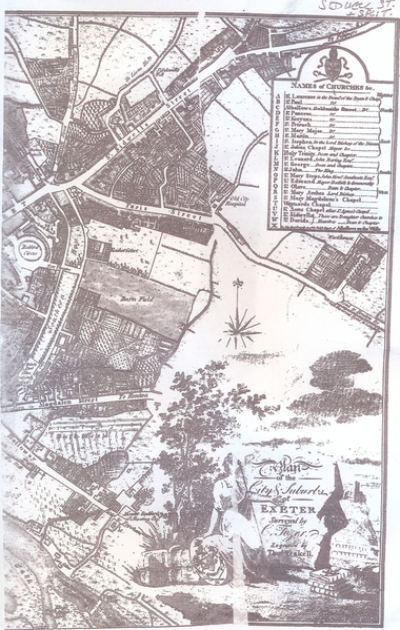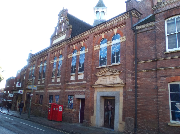
Exeter Local History Event
Visit to the Barnfield Theatre on 14 January 2016
We started with a fascinating journey through the history of the land on which the theatre was built, from the early 1600s to the present day. Malcolm produced copies of maps from 1618, 1702, 1805 and 1835 which showed how the area had changed over the years.
He explained, using the maps, how Southernhay had developed from a city ditch outside the city walls to a filled-in ditch with gardens laid on top of the infill. Then came the first appearance of the name "Barn Field" shown roughly in the centre of the 1702 map reproduced on the left. The site of Barnfield House is on the left of the Barn Field and on the corner of what is now Barnfield Road. At the right of the Barn Field was a valley through which the stream known as the "Barn Brook" still flows today. This carried surface water run-off from the surrounding fields to the River Exe (it is in this valley that the Magdalen Road Car Park – known locally as “the Pit” is now sited). The line delineating this brook can be traced from just south of Paris Street past the Barn Field, under Magdalen Street and under Holloway Road through to the River Exe.
Barnfield Crescent was not created until 1805 so is not shown on this map. A later roadway straight down south through the middle of Barn Field reached out to the Barn Brook valley and then turned to meet a greatly extended Paris Street.
Malcolm also told us about a lane in the north east of the city which led to a barn owned by a farmer named Rose. This barn, inevitably, became known as Rose's Barn and, when the farm disappeared under a vast new housing estate, the name of the lane was preserved as Rosebarn Avenue, similarly with Barnfield Road. Large barns were significant buildings and well known to the populace as the venue for the annual "harvest festival" for local people who had helped the farmer with his harvesting.
The last 1835 map showed the great expansion of building in Exeter by then, with modifications to the roads due south of the Barn Field, a large workhouse to the south east of the city and new roads heading towards London and Bristol.
Vicki Bowring, the theatre's Marketing Manager, then took the floor but first we went outside to examine the main building, opened in 1891, with some very attractive wall and roof tiles and its interesting cupola on top. Sadly, the original bell has been replaced by a ventilation shaft. The building was paid for by the Exeter Literary Society and erected in the garden of Barnfield House (the land having been bequeathed by the owner of the house).
We then came in from the cold to visit the Little Barnfield Hall which had been added in 1894. Its Clifford Room’s beautiful and unusual ceiling (left) is entirely original and, apart from painting, has needed no structural attention at all. Its design is much enhanced by its most attractive vent covers (below).
The building escaped the blitz and Vicki reminded us that, when the GPO was bombed, the staff – overnight – gathered all that they could and re-opened in the Barnfield at 8 am that same day. The post office’s occupation was followed by the Civil Defence and the Royal Observation Corps. An extension was built behind the main hall and, interestingly, this had a kitchen with separate restaurants for male and female staff plus reinforced concrete ceilings. One wonders quite what these organisations were up to to justify such a level of security ! This space now serves as a green room and changing areas.
From there we moved through to the stage of the main hall to gaze out at the seating area – some of us were familiar with this view from acting in panto as children. Vicki told us how the hall had at one time contained a floor which could be tilted. Chairs with longer front legs were then needed. Subsequently, however, a permanently sloped floor was installed which is what we see today (although the original screw-jack raising system still exists). The ambition now is to level the floor, using foldaway seating with tiered seats and to install a balcony. This would enable more people to attend shows and also make it possible for the room to be used for the sort of events it originally housed – fairs, dancing, meetings and lectures, typical of village hall events, only larger. The hall was in due course licensed for theatrical entertainment which is of course its mainstay today.
The building is owned by the City Council and rented from them, but their tenure is safe because the building’s designation as a theatre cannot be ignored. It is used by the Little Theatre Company for their annual pantomime and other entertainments through the year and is very popular with smaller professional touring companies and entertainers as well as many local amateur groups – dancers, singers and actors.
At the end of the visit, warm thanks were given to Vicki and members were so impressed with the theatre’s organisation that they were happy to contribute to their charity box.


